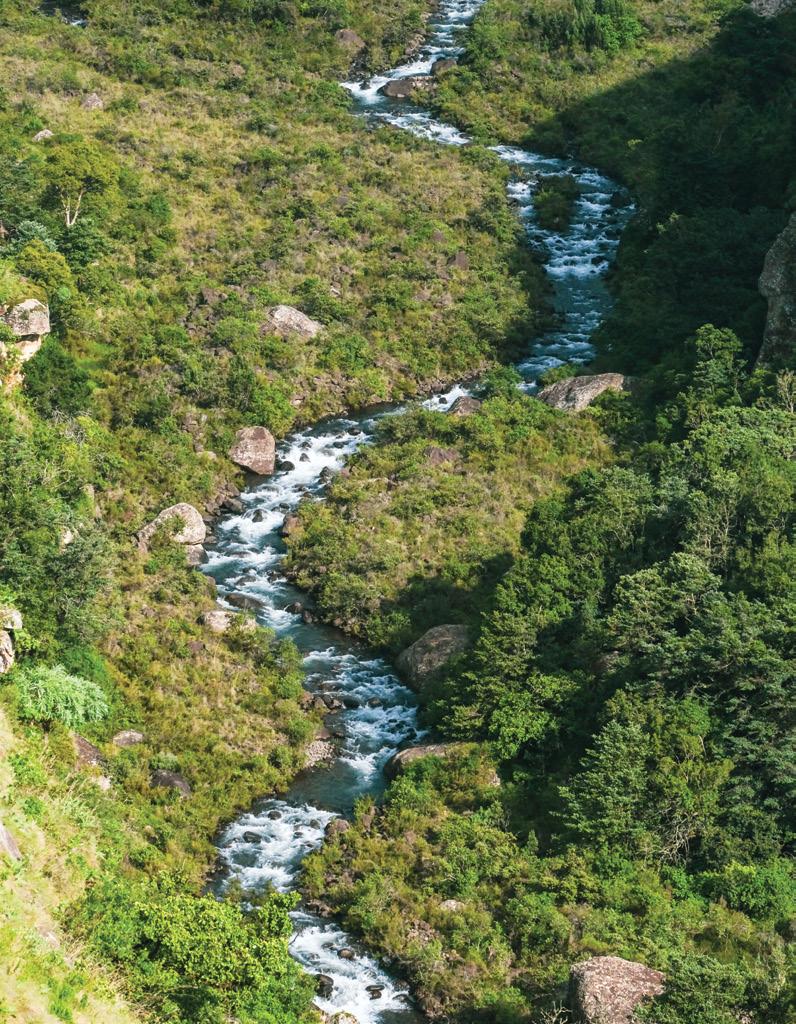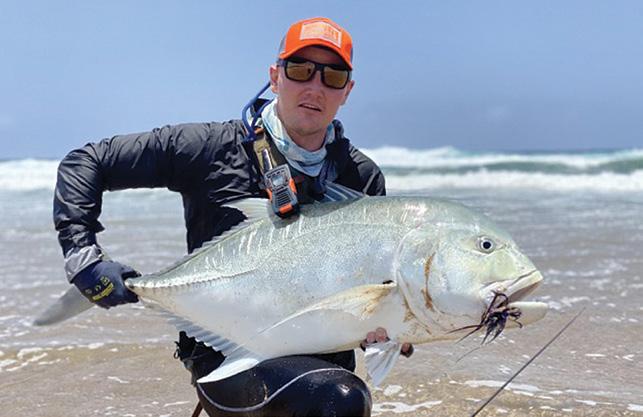
65 minute read
THE FEATHERS AWARD
FROM MASSIVE TARPON, SNAPPER, GT, LARGEMOUTH YELLOWS AND GRUNTER TO RARE INDIGENOUS FRESHWATER SPECIES AND A COUPLE OF SALTWATER TARGETS THAT MAY HAVE NEVER BEEN CAUGHT ON FLY BEFORE, THE INAUGURAL FEATHERS AWARD ATTRACTED SOME AMAZING ENTRIES.
When we announced the Feathers Award in December 2020, we knew it would attract some very special entries. This was not only because for this inaugural competition we allowed for entries from any time in the past 24 months, but also because in our experience fly anglers in Africa are, for the most part, hard-charging lunatics driven to push the boundaries.
The criteria were simple enough. We were looking for remarkable fish caught on the African continent (excluding Indian Ocean island nations). While big fish will always get extra points, it was not just about size. Other things we looked at included, the rarity of species, the challenge involved in catching it and the location you had to go to to pull it off.
Our judges are the Feathers & Fluoro brains trust, plus those of us who work on The Mission. We are a very mixed bunch, ranging from anglers who obsess over big fish in far out destinations to others just as happy catching rare indigenous species, trout and other aliens of any size, as long as the challenge is satisfying. Collectively, this omnivorous motley crew has fished just about everywhere from the width and breadth of South Africa, across Southern Africa, East, West and Central Africa, the Indian Ocean islands and atolls, to more far flung places like South America, New Zealand, the USA, Socotra, Iran, Christmas Island, Fiji, Australia, the Mediterranean, Europe, Mongolia and beyond. So, when it came to picking a winner, there was nothing homogenous or one-dimensional about our Supreme Court.
Above: Jack Lotter with a 104cm Giant Trevally caught off the beach in northern KwaZulu-Natal. Right hand page from top left: David Reverdito’s largemouth yellow (one of two caught in quick succession on the Vaal river, Ed Ghaui and his Goliath tigerfish, Leonard Flemming and his Witvis, Arno Matthee, a happy client and a 200lb tarpon in Gabon, Thomas Camp with his Cubera snapper, Jimmy Eagleton’s jut jaw.
The entries did not disappoint. Some of the fish entered, we knew about and had already admired on social media. Others were new to us. There were big fish and rare fish, fish that are relatively common but are seldom caught on fly and others (the fish, the angler and the setting) that were so batshit crazy we could scarcely believe that someone managed to pull it off. For big fish we did not need to look much further than the gargantuan tarpon caught by Dale Waterman, Peter Whittaker and Warren Pretorius with Arno Matthee the master guide behind The Guides Company operating out of Gabon. There was also the madness of fly fishing legend Jeremy Block’s broadbill swordfish caught at night off Kenya and the massive snapper caught by Thomas Camp off the beach at Sette Cama in Gabon with the African Waters crew. As one judge said, “that is a ridiculous snapper. If I was judging by the, “What fish of all submitted would you most want to catch” then hands down this snapper is it for me.” Perhaps the pick of the big fish was the 104cm GT caught off the beach in Northern KwaZulu-Natal by Jack Lotter of Dark Tide, a remarkable fish that earned him a place in the rarefied company of The 100 Club. There was also a big grunter from Niel Malan, as well as great largies and accompanying stories from David Reverdito, Mike Dames and Graham Forrer.
Then there were the rarities, the weird and wonderful species, both fresh and salt, that are seldom, if ever, caught on fly. We estimate that at least three of these entries may be firsts on the long rod. Our collective minds were blown by: - Jannie Visser’s Belman (a species we featured as a Wish List Fish two years ago, asking readers to figure out). A full story on that is in the works. - Jimmy Eagleton’s Jutjaw (a species rarely caught by any anglers let alone fly anglers and which Jimmy caught after climbing down a cliff face at Cape Point), - Leonard Flemming’s two rare cyprinid species, the critically endangered sandfish and witvis, which he has not only pursued pretty much single-handedly but also caught massive specimens.
- Last, but most definitely not least, was Ed Ghaui’s Goliath Tigerfish. He and Francois Botha of Goliath Expeditions have been scouting remote water in the Congo and Central African Republic for a few years now, working to set up a destination and there are few fly anglers who have caught Goliath tigerfish on fly.

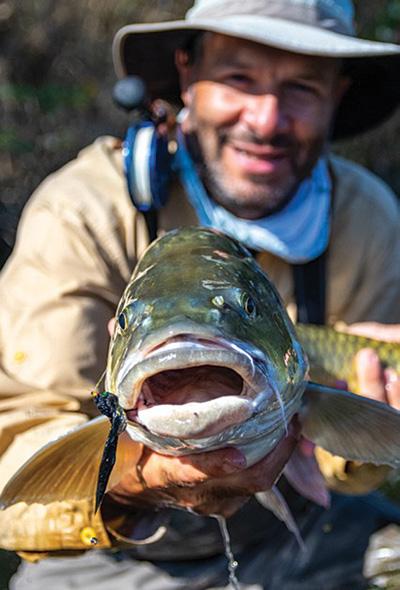
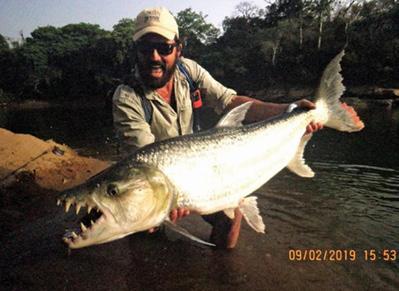


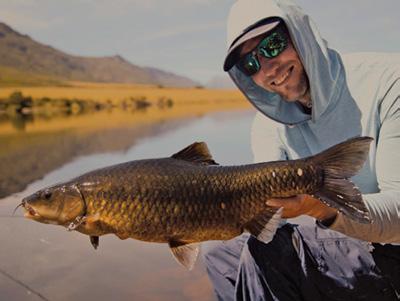
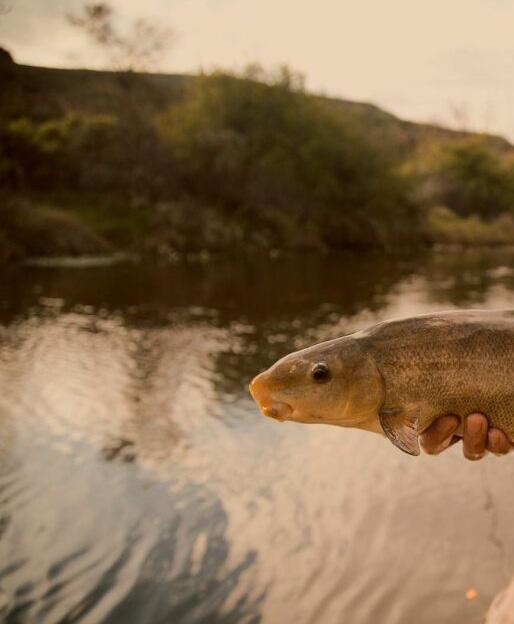
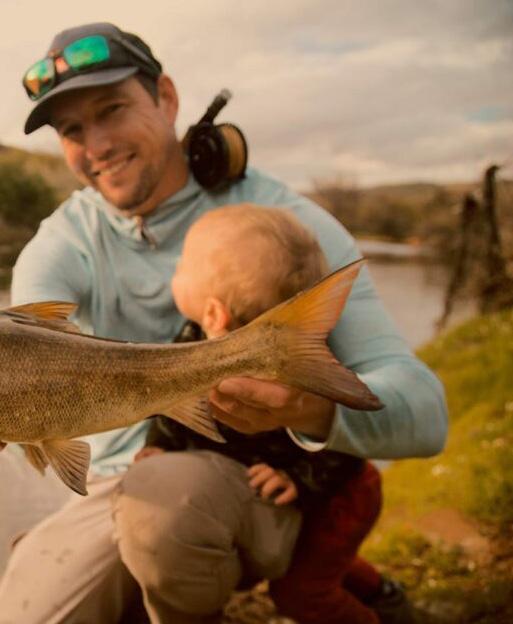
Barns Ghaui co-winner of the inaugural Feathers Award with a huge Niger Barb
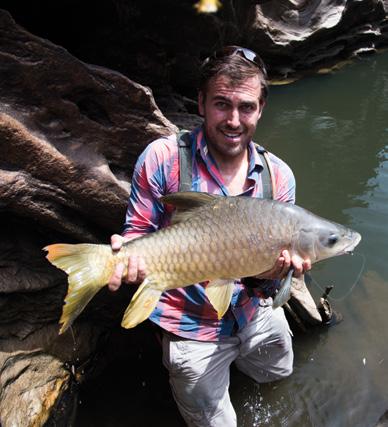
Comments from the judges included: “Jannie’s Belman makes me wanna cry. I have dreamt of being the first to take one on fly. For years I have wondered why a kissing cousin of ‘Merica’s redfish and corbina is not a well-known fly rod target. It appears the answer is that they are blind as bats and just don’t look at flies. If that’s not the case, finding them consistently feeding within range of a fly rod cast is just not a common sight. As if that has ever stopped Jannie Visser. Die bliksem.”
“Having both seen, and heard many tales of these fish, and know just how many people have spent hours and hours throwing flies at them with zero luck, this is truly exceptional to finally see one successfully targeted. No surprise it was Jannie Visser who finally got it right..”
“Belman are truly a fish of a million casts, and getting one on fly is way better than a milky in my book. Near impossible.”
“Eagleton is to SA saltwater fly fishing what Flemming is to hunting cyprinidae. He has taken many firsts in SA, but to go spelunking and abseiling after a fish that no one even catches on bait, and getting some, takes the cake.”
“Len’s efforts in finding and decoding indigenous cyprinids are unmatched. I find his sandfish and witvis catches equally impressive. Given the size witvis he has taken, it is kak hard to top. Combine the effort required with the rarity and size of his witvis and colour me fucking impressed.” “Sandfish for the win as it ticks all the boxes - a lifelong dream, immensely difficult to find, ridiculously difficult to catch, and a tank!”
“Ed Ghaui’s Goliath Tiger – In a world of ever shrinking wilderness, a Goliath on fly must still surely be the most hallowed, and likely most difficult fish to find, and target on fly successfully.”
Despite the high praise for all of these anglers and their catches, once the votes were tallied the winner of the Feathers Award went to another entry - Ed Ghaui and his brother Barns, for their efforts with Niger barbs in Gashaka, Nigeria (as featured in issue 16 of The Mission). Not only did these Kenyan adventurers take a chance and mission off into an area that was on nobody’s radar as a valid fly fishing destination, but they discovered what looks like a veritable fly fishing Garden of Eden. Huge, broadshouldered Niger barbs that had likely never seen a fly before, fighting each other for the Ghaui brothers’ flies. They also caught another as yet unnamed species of barb. Oh, and Nile perch… as by-catch. Then there was the hardcore motorbike ride to even get close to where they started hiking and the incredible beauty of the surrounding area of forests, mountains and chimpanzees.
The judges had this to say: “Beauty, rarity, location, difficulty, only caught by a handful of fly anglers, one of the best looking indigenous fish in Africa in my opinion.”
“Those Niger barbs in Gashaka, Nigeria take the cake because of the mission that they had to go on, the exploratory element of it to find a fish that has most likely not been caught on fly.”
“A big criteria for me was the risk involved in catching the fish. Not necessarily the risk to yourself, but time risk, money risk. To go to Nigeria, all of those risk boxes are ticked. It’s a tough place to go logistically, you don’t know what you are going to find. It’s the essence of what we are looking for, getting out there, taking risk, putting in the hard yards and getting the rewards.”
Editor-at-large Conrad Botes is an artist and he is busy working on a floating trophy to which the names of the Ghaui brothers will be added to be memorialized for eternity. If you would like to see your name on that trophy around this time next year, get out there, take on that mission and send us the story.
You have just under 12 months. Hop to it.
KOB CRAZY AT KAROOLSKRAAL

ONE OF SOUTH AFRICA’S BEST SALTWATER FLY FISHING DESTINATIONS, KAROOLSKRAAL FLY FISHING CAMP ON THE BREEDE RIVER BOASTS NOT ONLY INCREDIBLE FLY FISHING FOR KOB (SEVERAL GIANTS OF 100CM + HAVE BEEN RECORDED), BUT ALSO BRILLIANT OPPORTUNITIES TO TARGET SPOTTED GRUNTER ON THE MUD FLATS AS WELL AS THOSE HIGH-SPEED ADRENALIN JUNKIES, LEERVIS. ADDED BONUS - IT’S LOCAL, SO NO PASSPORTS REQUIRED.
The Karoolskraal experience includes comfortable tented accommodation, eco-ablutions, all meals and drinking water. We can also provide a spit braai on request. Open for day trips, 3-day or 5-day stays
SEYCHELLES THE TOUR DE COSMO
A LOT OF THINGS WERE OFF THE CARDS LAST YEAR… FREEDOM OF MOVEMENT AND ASSOCIATION, TRAVEL, EVEN BOOZE (IF YOU LIVE IN SOUTH AFRICA). FOR UK-BASED, FORMER SPRINGBOK BOB SKINSTAD AND FRIENDS, THERE WAS A BRIEF MOMENT IN THE MOLASSES OF LOCKDOWN TIME, WHEN THEY WERE PRESENTED WITH A GOLDEN OPPORTUNITY TO EXPERIENCE SOME OF THE BEST SALTWATER FLY FISHING ON THE PLANET. NOT EVERYTHING THAT GOES ON TOUR, STAYS ON TOUR.

Story: Bob Skinstad Photos. Alphonse Fishing Co.
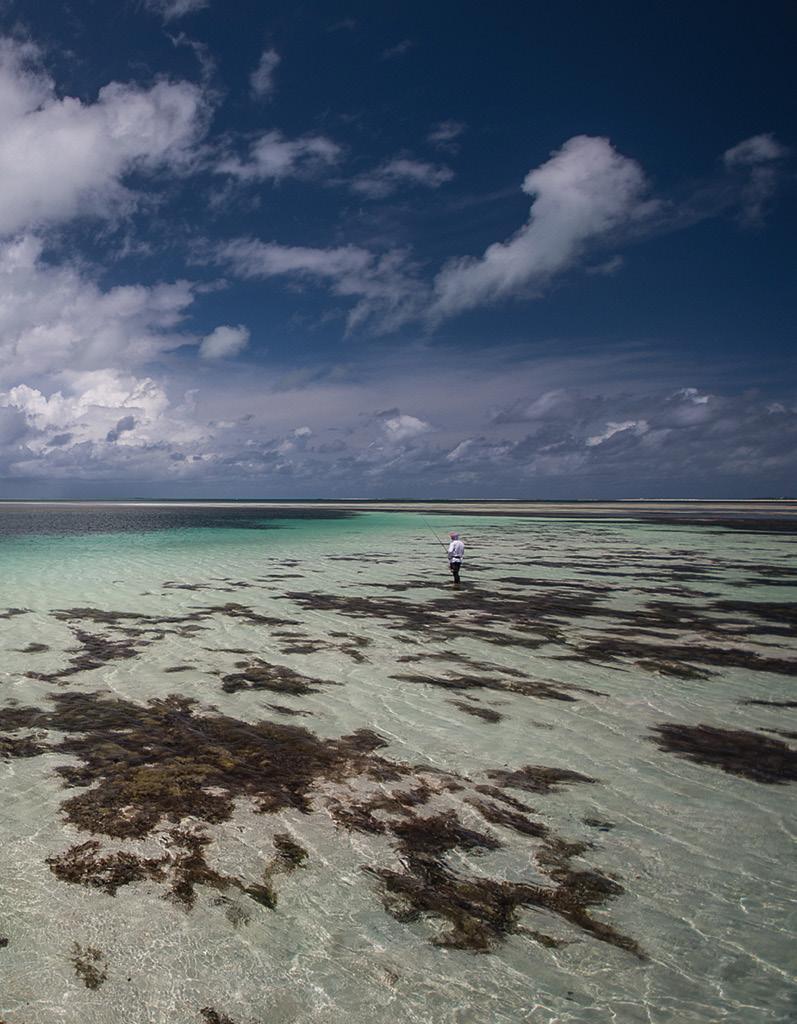
“Cosmoledo. Two weeks. December. It’s back on. Get on it Skin, ‘cos you’re in.”
That’s a big, big WhatsApp message in my world, especially when it’s come from my friend, cricket international and fly angler, Justin Kemp (aka Kempy). Justin was introduced to fly fishing late. He’d grown up fishing but after being a bait skate for so many years, his move to fly was started by myself and few friends. But, in a true Jedi/Star Wars parallel, the student has completely surpassed the master. The human Goliath Heron of fly fishing is unstoppable. It’s not just his own fishing, but after he and his partners took over Upstream Flyfishing in Cape Town a few years back, it’s become what he does now. With a capable crew, a well-stocked and well-run shop, and working as a tour operator, Upstream has created a reason to be excited for many long time fly fishing enthusiasts. That message from Justin meant a lot to me because it came at the end of 2020, with its travel restrictions, lockdowns, family illnesses etc., a long and difficult year for everyone. Because I had fished with most of the guys joining this tour before, and a few new big names were also invited, it was a trip that absolutely couldn’t be missed. The crowd was top class and I already knew what to expect from the fishing. After you’ve experienced the first visual, brutal take of a Cosmo GT on fly, the raw power and early thrust, seen a clumsy angler dancing the tangled line jig on the foredeck of the skiff, with millimetres and milliseconds of luck between losing and taming a fish, you’re hooked on that high for life. Once you’ve tried to stop the zig-zagged sprint of a trigger fish or felt the long, swinging tail bounce of a deep, downward running milkfish bending line off your rod, there is only so much satisfaction you can get from a river brown rising to a mayfly, a tussle with a sluggish carp or another introductory lesson at a hatchery for your very keen offspring.
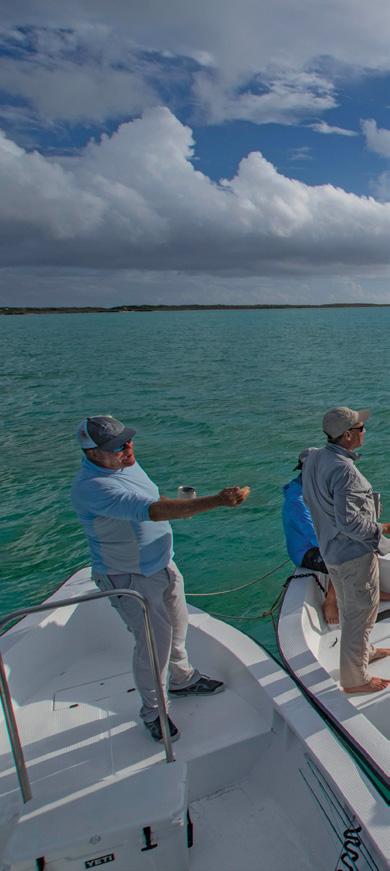
As I put my phone down and started my mental packing, my memories were triggered. Senses on high alert, I could feel the tremors already. This was going to be an extra special trip.
For most of the year, the very idea of a two-week trip to Cosmoledo in 2020 seemed impossible (for obvious reasons). But fishermen and mates have a way of achieving the impossible. Luckily there is always the chance of things coming together and they did. I had a valid Covid-19 PCR test so, when, for a brief glorious moment both the Emirates and the Seychelles fell into a collaborative joint travel corridor, an opportunity opened up. The tour was on!
The boys tethered up just offshore from camp once a week or so to hear the stories fresh and finish any ice cold Seybru beers from the coolers.

Above: Ray Cadiz strikes gold with an Indo-Pacific permit. Opposite Page: Bruce Neill and a GT have a staring contest with us.

Lockdown Break in the Clouds
From my rugby career to my life post-rugby, tours, in all forms, have been an irreplaceable part of my annual calendar. Dates to work towards, they are the tonic that make the day-to-day drudge bearable and they make the pure time with family, work and everything else all the more pleasant. The most important part of a tour is the friends who join you, who share a common passion. Sometimes it’s a golf tour or a sports tour to a major event, but fishing is often one of my main reasons for going on tour. I have found that, if you love to fish and love to travel, you do not run out of places to go.
The team and tour rules change from destination to destination. The jolly goings on are a huge part of why our trips are a success but, on this one, they were only peripheral to the main meal. How could they be anything other than a bowl of nuts before the grouper fillet, or a popcorn bite to the lamb shank main? The real achievement was the hard work of the guides and staff, because for us, just being at Cosmoledo, the best of Seychelles, made this tour the unbeatable one.
Paradise at last
It’s a long trek from Weybridge in Surrey, but a worthwhile one. (big deep breath) Seven hours on Emirates; a solitary beer in the bar at Dubai International; four more hours on Emirates; customs (with PCR!!) a catch up at the IDC lounge in Mahe; board an island hopper; an hour to Alphonse; another beer 90 mins; to Astove; a quick beer and about an hour (weather dependent) by boat to Cosmo.
Some of the team had flown across from South Africa via Johannesburg while a few more had jetted in via Air Cadiz, stopping for a night of prawns and stories on the beach in Mozambique before joining us on the runway at Astove. The early rapport was good, the fish were nervous and rightly so. Everyone on this trip could fish. A raised coral atoll that runs 17 km in length from east to west, and 12.5 km from north to south, Cosmoledo is only 5.2 km2 in area, but the lagoon and the reef flats have an area of 145 km2. You are not going to run out of water to fish. The closest island is Astove, 35 km farther south.

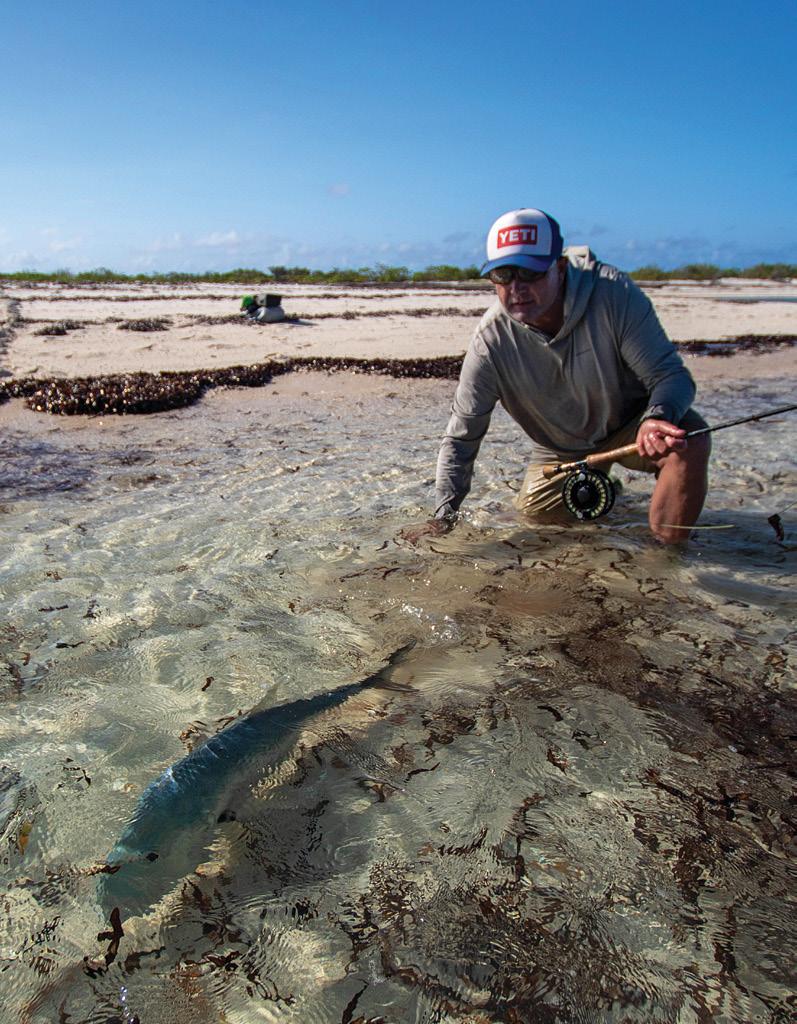
The main eco-camp at Cosmoledo is set up on Wizard Island. All the accommodation is in incredibly comfortable, prefabricated container-like rooms, with showers and ablutions added on to each one.
The guides and camp staff share similar digs but they are tucked away, near a camp mess area, and aren’t part of the main accommodation and pathway. You feel like it is just you and your friends on the island. There is a central dining and leisure area with Wi-Fi, bar, emergency comms and a small store of provisions that you might need for going about your day with some replacements for fishing equipment, hats, shirts and general paraphernalia.
The food is exceptional. Having seen the small boxes of provisions that come in, I really don’t know how they do it. Obviously fish and other sea food options are readily available but what they do with the very little they have is absolutely outstanding.
Pete Stewart with a little black bomber of a GT.

Pete Stewart with a cracking beach-side Barracuda. Bob Skinstad and Justin Kemp after the latter swooped and caught a triggerfish by hand.
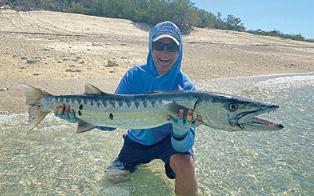
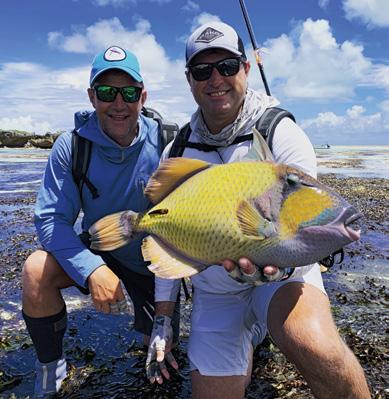
Every day a fantastic breakfast is served from 7am. Anglers enjoy a traveler’s meal on the boat, which the guide will get you to stop and enjoy. On your return from fishing and a freshen-up, you come back to the main tent pre supper and an evening time gathering begins. My first day nerves were shattered by an 8.15 am strike on a small, angry, black, fast torpedo of a GT. Missed. Shit! First cast, first mistake and then those self-same nerves were settled by more fish coming round the corner. Never mind, chin up!
The light breeze provided a bit of respite on that first day and, fishing with an old friend Matt Ferrey, it was easy to get going because the fish were playing their part. All the first-timers on GT were into the thick of things very quickly, and kept getting hungrier and reaching for more.
Mother Nature certainly played her part, and we were treated to a show like I’ve never seen before. The week had started well and got better… a feast of GT gluttony during which 59 GTs were caught in just one day! Unbelievable. There were big fish around too, and stories of straightened hooks and smashed tackle were told all week, my own included. In fact, I lost a good milkfish, a great GT and a small trigger all on the same day. Splendid!
Evening bell ringing tradition at Alphonse Fishing Company is legendary and we had a daily pre-supper fines session started off by Head Guide Cameron Musgrave with angler, guide, and host contributions. So all the stories were recounted, shared and enjoyed.
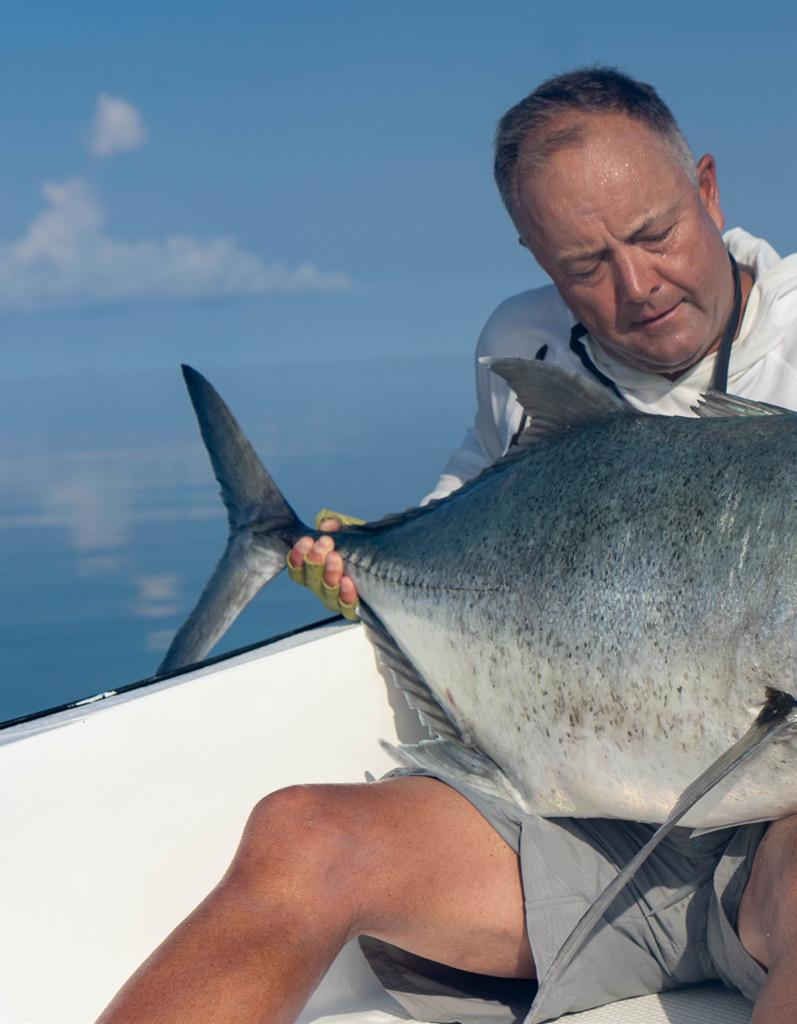
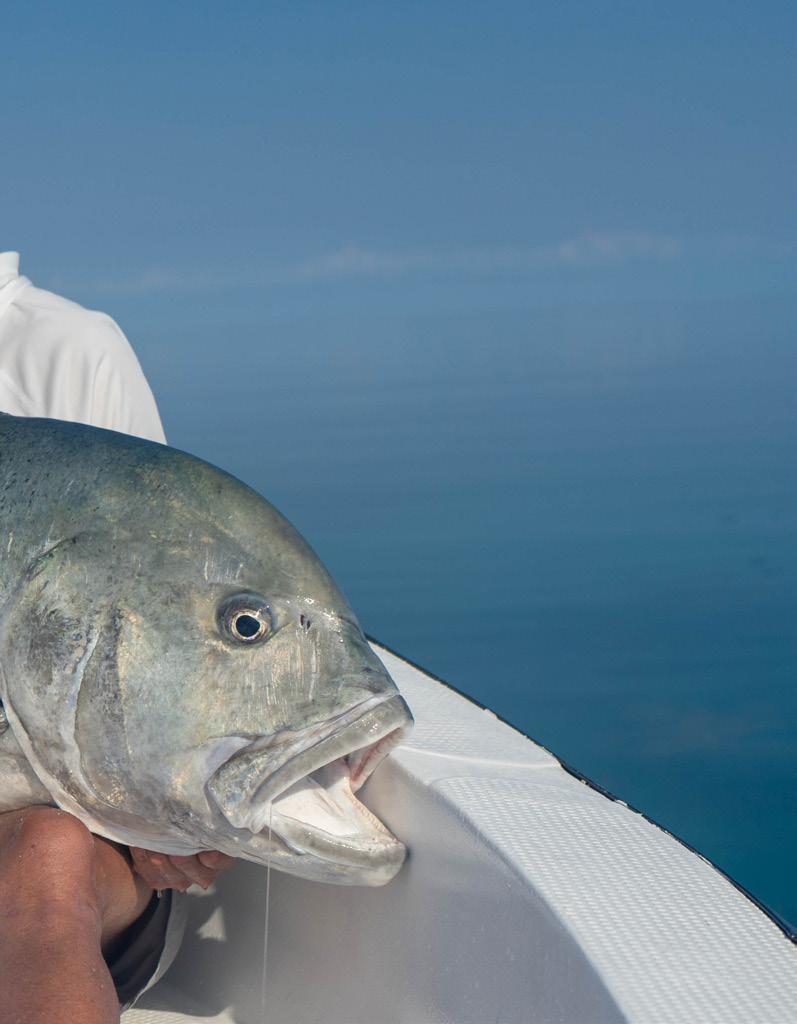
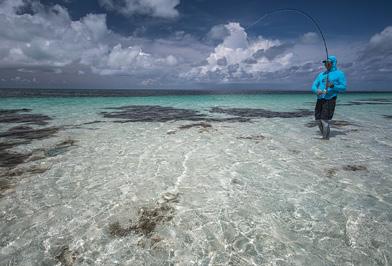
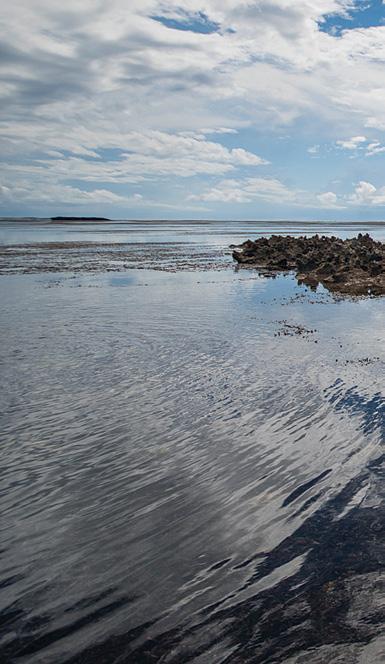
Top and bottom Gary Neill with the fight and the ‘present’ The rest of the session was admirably managed by the inimitable raconteur, Ray “Puddles” Cadiz, a cunning linguist, lovable rogue and bull of a man by nature. The fines meeting with its daily boat-naming (focusing on a big incident in the day), and the CTFD (Calm The Fuck Down) award were all highlights. The CTFD award is a piece of fishing history, because, when a hungry GT lights up like a Christmas tree and accelerates towards your hapless fly, all hell breaks loose. It’s extremely difficult to breathe, let alone concentrate, and it’s most difficult to stay calm. So we celebrated each day, with a drink for the small but crucial mistakes that lost us the famous and favourite fish of this atoll and broke our lines, rods and hearts, and reminded ourselves, after a long and funny day, to try and “calm the fuck down!” The week continued with the hunt for personal bests and mantelpiece evidence, and a few of the highlights included a cracking day for Matty Ferrey, Humewood’s finest. Well guided by Brandon Poole, Matt notched a lifetime memory when he bagged a 123cm GT on a brush fly in the lagoon, which was spotted a little after 8am after it was seen on the first run out. To top it off, a Boha snapper even tried to crash the party.
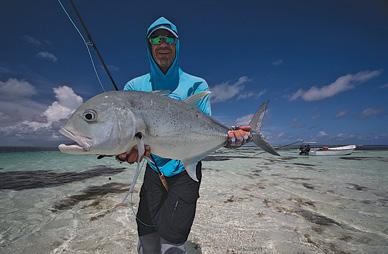
Richard “Puppy” Came and “Uncle” Pat Quarmby both caught good fish and told good stories, Pat getting an admirable tally of 15 GTs in one day, as well as some solid bonefish in the pristine, rising tidal flats. Always fighting the nightly ageism chirps and inspired by Toby Keith’s “Don’t let the Old Man In”, Puppy was heard to mutter that the younger tourists should choose their descriptions cautiously.
Pete Stewart had some personal records to beat, including a GT over a metre which he duly did, and got a cracking beach-side photo with a Barracuda too. We are not a traditional group, so don’t chase numbers exclusively, and we look for experience over accumulation but, on any measure, a tally of over 200 GTs for the first week was exceptional. The weather was a lot more iffy on week two, and the wind played more of a part but the nature of the fishing changed, and the spring tides rolled towards us. GTs were hunting on the flats and smashing bait and more on the edges of cliffs, island channels and quickly filling sandy high spots. We often talked about how lucky we were as we responded to the sights and sounds around us. Some of the boys took a Nat Geo outing to watch a huge leatherback turtle laying her eggs in a sand dune, big rubbery paddles flicking furiously with sand and coral bits flying everywhere… a truly special sighting. The birds at Cosmo are also incredible: Diamorphic Egrets, stalking the flats like ever-linked Yins and Yangs, cleaning up the frayed and tattered life on the edges of the coral cities; Red Tailed Tropic birds rolling over each other in an ancient dance, and the various Boobies, low and wary, evading the Frigates, dangerous pirates of the sky, on their last run home to feed the family.
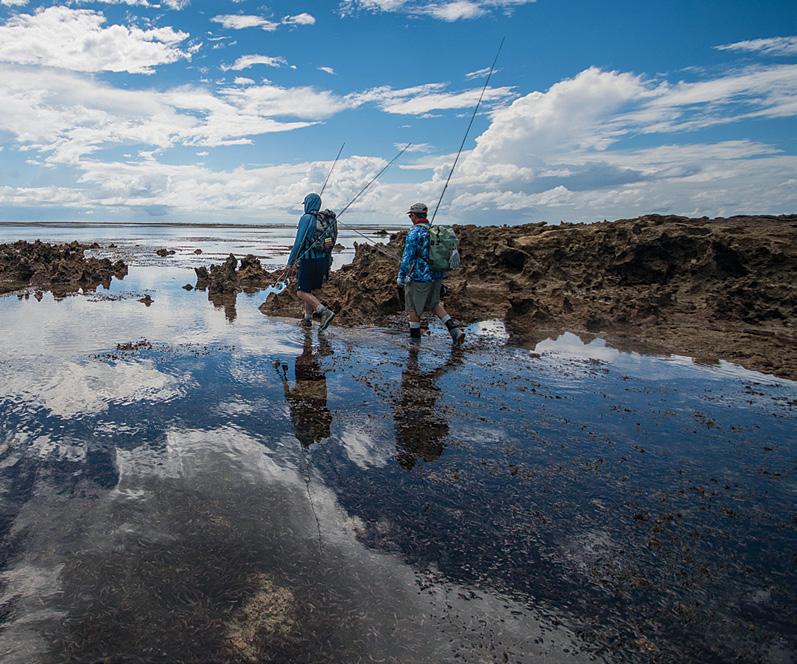
I had a day out with Kempy, and the luck was running my way. The GTs had atypically been very close and were almost tailing in the murky sandy water of a washy tide,
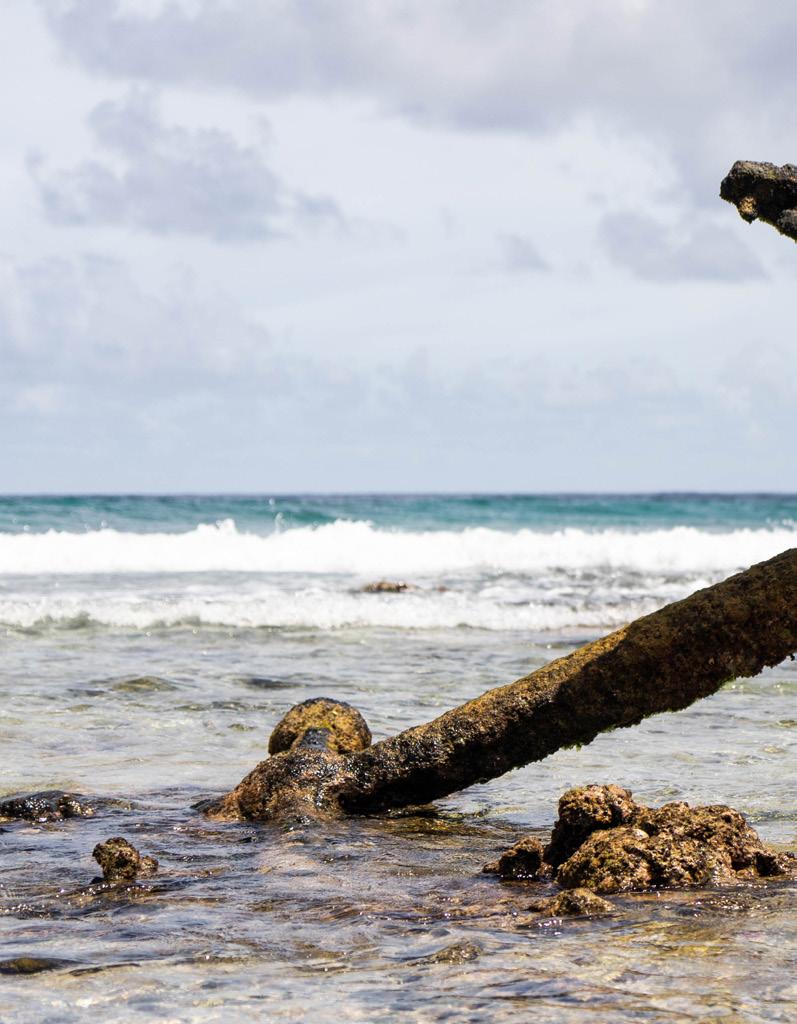
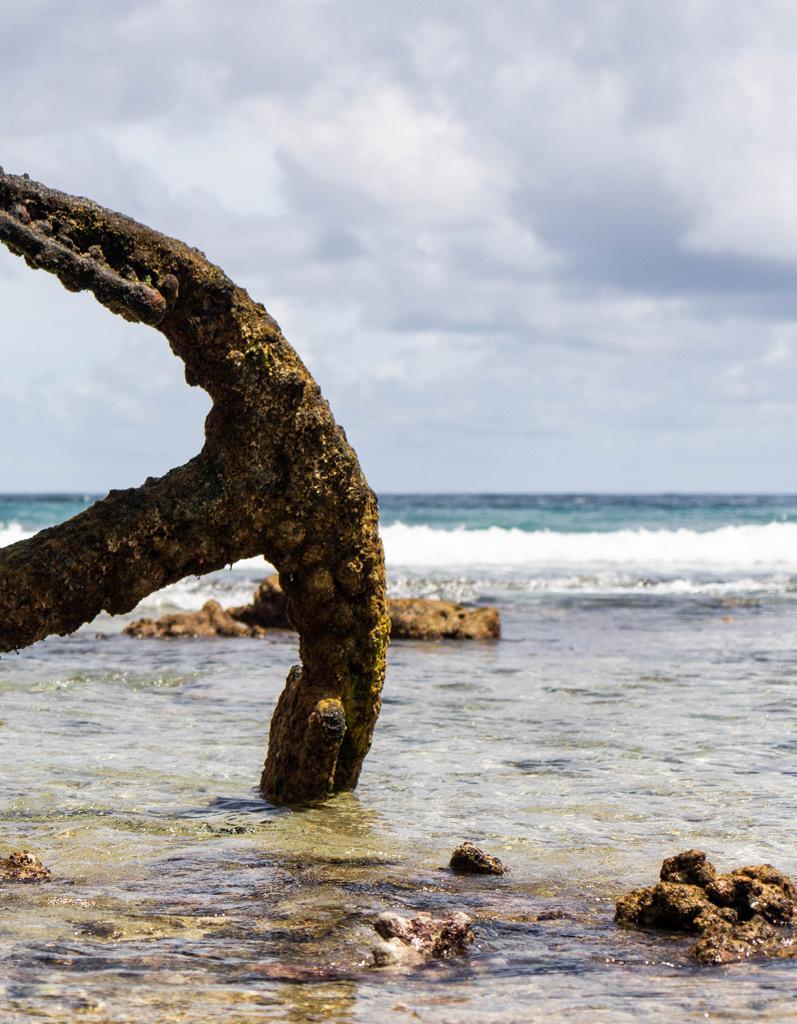
Almost time for the day’s ‘Calm the Fuck Down’ Awards at Cosmo.

but I’d managed to snag a few. Kempy was determined to nail another trigger and as the pools on the higher ground emptied out on the falling tide, he got his chance. I had a ringside seat as Angus Forsyth, our guide for the day, and Harding Cricket Club’s finest leg spinner, stood quietly and watched the human Goliath Heron do some of his best work. Cast after frustrating cast was refused, but the big trigger was dangerously close to being trapped and Kempy’s instinct kicked in. He ditched his rod, ducked and scrambled across the first bits of coral and then, with a few long strides and a swooping, whooping dive, he pounced on the startled trigger that had beached itself in the frenzy.
It was a magnificent fish. We grabbed a quick photo before we sent it back to tell the story about how it got away. In the photo, notice the glaring absence of a rod of any kind.
Cosmic Candy
We had a chance to test out some new flies and retrieves, and the Upstream masters have managed to tie a beauty. A bulky fly with a woven, matted cap, it looks like a squid or octopus caught out of its comfort zone, and the strike rate on the bigger, less actively feeding fish was incredible. At one coral bombie, Kempy had four fish, which were too close to the boat for a solid strike, take and eject the fly, then the fifth fish took it and was duly landed. The school of fish had circled the boat and the bombie, refusing everything we threw near them and always seemed a little too deep for the quick retrieve to be effective – a truly interesting leap in how we have fished for and caught these GTs.
A final goodbye loomed large and, after another week in paradise, it was a very heavy- hearted group heading for home. We were keen to see loved ones and all the other perks of home but we were fully aware of leaving behind this truly enchanting destination. We were grateful for so much but, most of all, for Keith Rose Innes, Murray Collins and everyone at the Alphonse Fishing Company because, without their incredible efforts and unwavering commitment to the cause, these ancient and holy places would soon be ruined. They are truly exceptional and, after so much went wrong in the world last year, to see them, to watch and marvel at their skill, attitude and application, was a true privilege. Back home in the real world of grim lockdowns, tiers and vaccines, it seems even harder to comprehend how this Cosmo trip came about. There’s something to be said for the determination of those within our group who make things happen. The goaders, the hecklers and the organisers, people who commit whatever the cause. You know who you are! To my fishing friends and brothers, I will always raise a glass. I look forward to missing a strip, spooking a fish, or casting a frayed leader with you all again, one day soon.

COSMOLEDO SHOP THE MISSION

SIMMS - INTRUDER BOOTS
Half the team wore the new Patagonia/Danner collab boots, the rest used Simms. I had the Simms Intruders. simmsfishing.com, upstreamflyfishing.co.za
PATAGONIA – SANDY CAY SHORTS
The lighter the material and the longer the shorts, the better. patagonia.com, upstreamflyfishing.com
Patagonia Hooded long sleeve hoodies were the best choice by far (notably used by all the guides).
patagonia.com
YETI - PANGA BACKPACK
Waterproof and tough as nails. yeti.com, upstreamflyfishing.com
SHILTON - SR10 AND SR12 REELS
Bulletproof and South African, what more could you ask for? shiltonreels.com, upstreamflyfishing.com
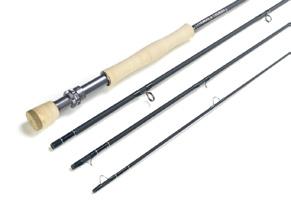
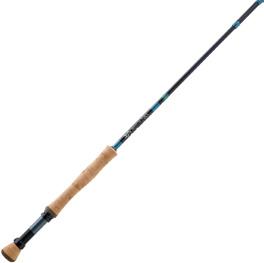
MERINO SKI SOCKS
I lucked out by trying some Merino skiing Socks, and they were outstanding, pulled up to the knee they helped with sun protection as well as being comfortable and breathable. Falke AR4 Vitalizer, capeunionmart.co.za
PATAGONIA – TROPIC COMFORT HOODY II
G. LOOMIS - NRX 12-WEIGHT
What I used for GTs. gloomis.com, upstreamflyfishing.com
THOMAS & THOMAS – EXOCETT 10-WEIGHT
What I used for everything else. thomasandthomas.com, upstreamflyfishing.com
SOUNDTRACK – Black Mamba Boy – Black Mamba Boy Don’t Let The Old Man In - Toby Keith / Clint Eastwood (The Mule)
THRIFT 1 IN BETWEEN CATCHING FISH
FOR THE HALF-BAKED STUDENTS OF THE RHODES UNIVERSITY FLY FISHING CLUB, GOING TO THRIFT IS AS MUCH ABOUT THE DESTINATION AND ITS TROPHY RAINBOWS AS IT IS ABOUT THE JOURNEY THERE AND BACK.
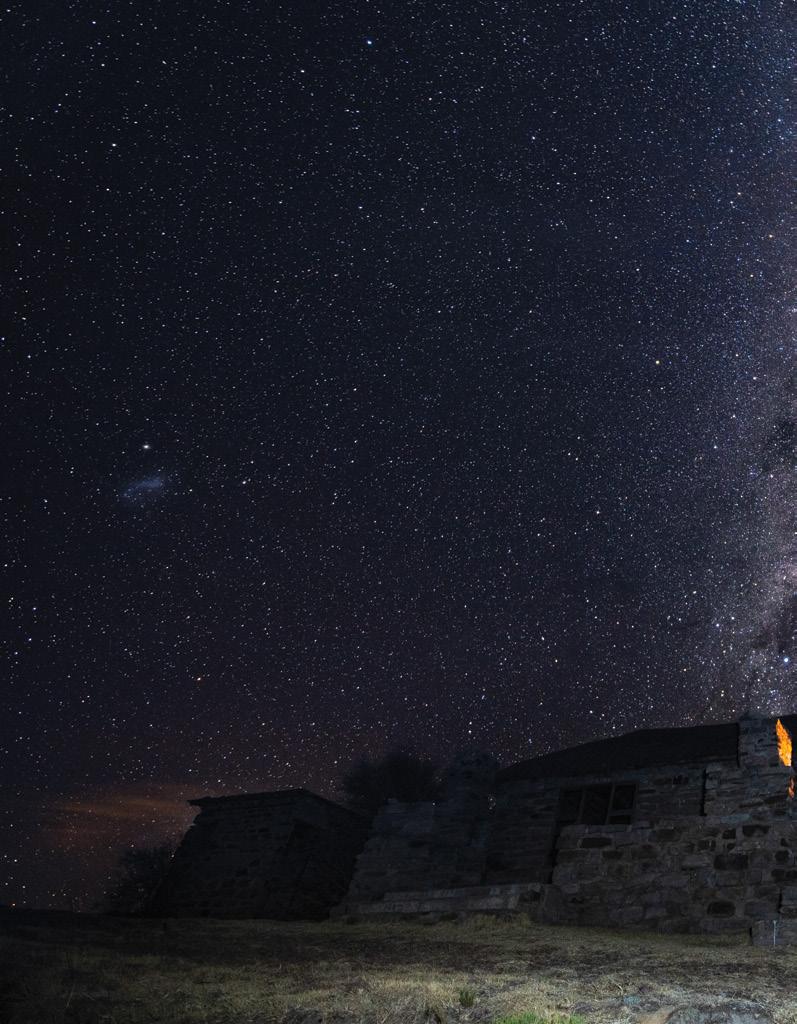
By Neil Hiestermann Photos. David Taylor
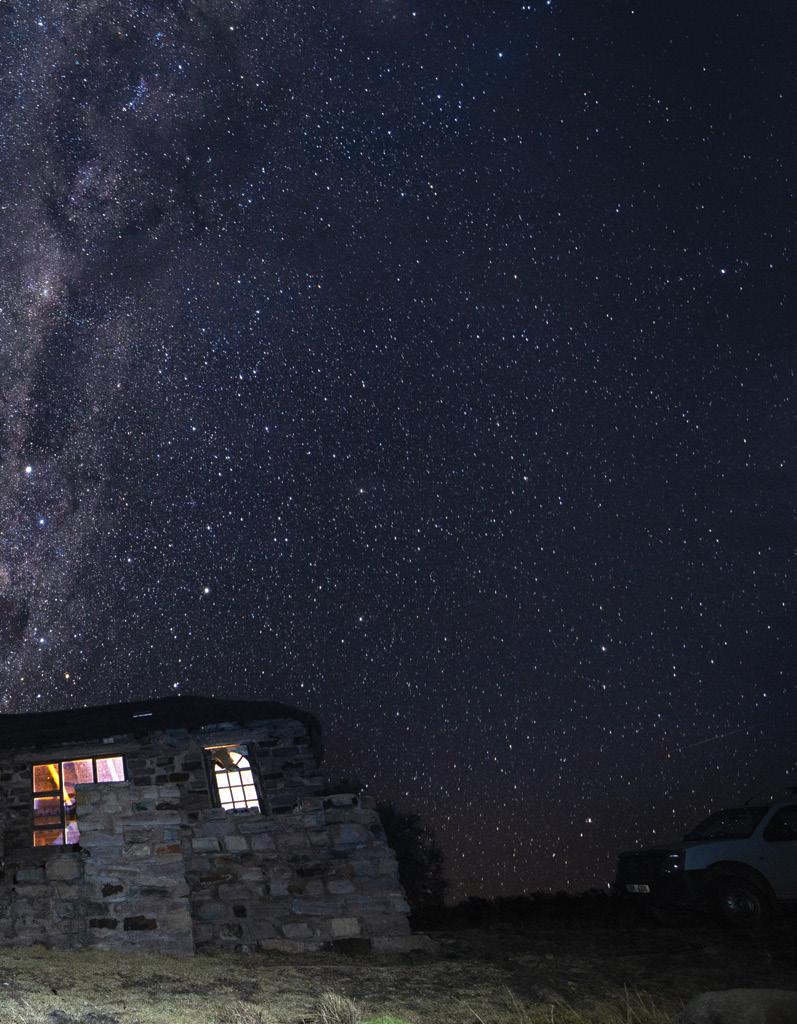
Am I being alarmist or is something reminding me? I’m aware of the possibility of the bottom. What happened to yesterday? I might have been lost in yesterday.

We leave the frontier country for Thrift on what was once a journey of a few weeks, but is now merely a few hours’ drive. Our home, Makhanda, formerly Grahamstown and the modest home of Rhodes University, is situated 50 odd kilometres north of the beautiful Sunshine Coast, approximately 140 kilometres south of Hogsback, just out of arm’s reach of the Sundays River in the west and far away enough from the Fish River in the east that no one tends to recall its existence. I think it’s safe to say that LieutenantColonel John Graham, the town’s colonial founder, settled too soon in this crack in the mountain. Out of giddiness or confused ego, he was definitely pissed off at Lord Charles Somerset for sending other British settlers to waai pozzie (make a home) in Port Alfred and Kenton-on-Sea.
It’s a slow town typical of the Eastern Cape. Half-baked roads supporting trash-curious donkeys and half-baked students. It is not uncommon to stumble across both making the bottom of potholes their homes for the night. I like to think of the town as the anthropomorphic village idiot of South Africa. Ah yes, we were busy leaving. We start the meandering climb towards Fort Beaufort, and behind us Makhanda vaguely resembles the shape of a soup bowl. Yes, it vaguely resembles the shape of a soup bowl but my wandering imagination and extensive (grade 9) geographical experience suggests that it accurately represents a pothole. I am the half-baked student. Fort Beaufort comes and goes, and the climb intensifies in the Mpofu Nature Reserve. The potholes and donkeys are replaced by boulders and dense vegetation and suddenly I’m overwhelmed, angry actually, at all the Hollywood directors for not choosing this place to depict “Africa”. The Mpofu highway shoots us out on to a grassy plateau of blues and beige. Winter has been cold. Around the first bend lies a farmhouse with no particular architectural significance. The next bend offers spectacular, panoramic views of the approaching Winterberg Mountains and the valleys below. It’s around this stretch of the drive that the first “Oh shit, ja, I remember this part” erupts unnoticed, and the trek up NO THRO ROAD Pass commences. Historically, this road was guarded solely by feverish cattle and alien San Pedro cactii. On my last trip, however, the guard was a cautious fellow in a single cab, adorned with Smhart Security stickers, who was busy searching for missing kudu. Unwilling to believe that we were, in fact, on a sophisticated journey to the mystical Loch Thrift for a weekend of dubiousness and a side of fly fishing, the Smhart man inspected our bakkie and, upon finding not even one kudu in the boot, wished us well. The cattle and cacti were not as interested in the investigation. At the top of NO THRO ROAD Pass we were greeted in equal parts by vagrant horses and disconcerting carcasses. Had I not taken geography in grade 9 and learnt of the snow-capped Himalayas, and without Juluka’s “Kilimanjaro”, I’d have been convinced that this place was at the top of the world. Eventually the horseshoe-shaped Loch Thrift came into view and I was no longer concerned about being lost in yesterday and the tiny town that is my home.
To be honest, nothing reminds me of yesterday or a yesterday more than a long drive through old pastures and rocky roads. I think of the first people who decided to call these places home, let alone those who ventured out there for the purposes of reconnaissance. I think of the months and years that went by with no one around to share a beer and a laugh. No beer and no one. Upon arriving at Loch Thrift it is customary to collect the cottage keys from Elliot, the official guardian. As a child going on various camping trips, the arrival process was never smooth. My brother and I were always employed (without immediate pay), to help set up camp, blow up the mattresses, unpack and build fires… all after a grueling nine-hour drive. There was no such thing as immediate gratification. And , although I am grateful for the tiresome lessons in patience, upon arriving at Loch Thrift for the first time and even the last time, this virtue was like the dreams you forget immediately after waking up. So real and true… but what actually happened? The Thrift Experience with the Rhodes University Fly Fishing Club (RUFFC) is oh so different and yet, much the same.
“Satan, King Satan, what the hell…!”
Those lessons in patience helped me to start the unpacking process: all the bags of wood to the fireplace, tackle at the work bench, suitcases under the beds, foodstuff in the “kitchen” and bedding ready for sleeping. However, this kind of advice from me was like the road rules in South Africa. Ignored. The hard legislation melted into courteous suggestions as I (The Righteous) watched in awe as my hedonist brethren ditched their duties to befriend a beer and rig up a crusty five weight. “Dad, oh Dad, what the

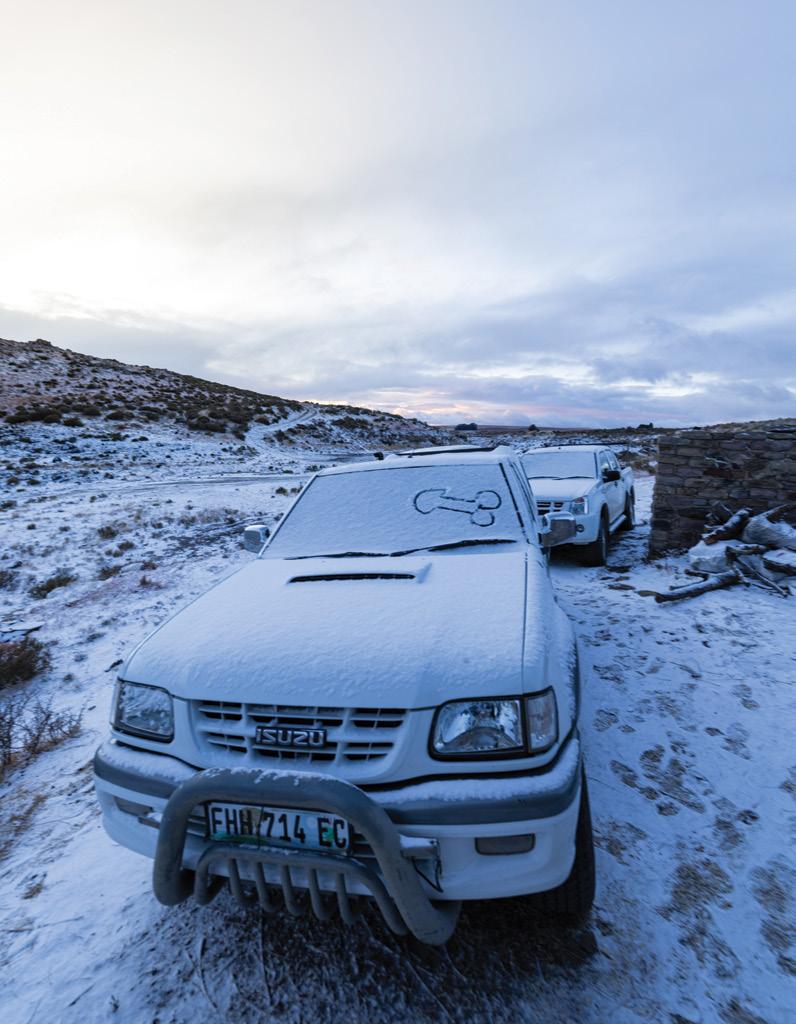
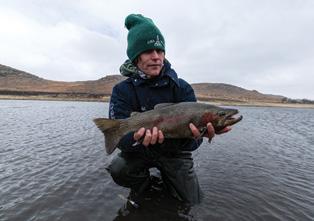
hell…!” I cried, as I packed my sleeping bag back into its cover and reached for my rod tube. Uncommon common sense. The universe is just and unassuming. Three beers in, a tippet tied on so lazily and windknots (or what Lefty Kreh more appropriately calls casting knots) left, right and centre, I got my just rewards. Not only was I paralysingly cold, I had no bed, no fish to my name and a groot gemors (a giant mess) to fix in the morning. I decided, as did my peers, to tuck into the sherry and brandy and slip into that awkward dream I would vaguely remember in the morning. Discipline did not suit the depravity of our spirits. I commented (maybe once) on the quality of the wine I had brought. Maybe. For no particular reason I’m reminded of an old notebook I was given, “For the stories you will write and the smiles that may follow”. It’s a beautiful notebook, leather-bound, approximately 200 pages, (papyrus), and all completely pristine. One morning, during coffee hour, a friend asked why I hadn’t yet used the notebook, to which I replied without thinking that I did not own a suitable pen. I don’t know whether I was lying or not. Perhaps a fine notebook needs a fine pen or maybe I don’t want to start it. This, in a complicated nutshell, is my requiem for Thrift Loch. Less about the fishing than the actual adventure and the people who are somehow willing to endure my gibberish and misguided, esoteric musings. Pen and paper, no words. I initially regarded Loch Thrift as a place of wild behaviour and awesome fish, some imaginary wonderland between reality and sensibility. And I treated it as such on my first few excursions. Thankfully, and in time, my friend Jim reminded me of my forgotten patience and that, with at least one cup of coffee in the morning, we could spend an entire day, enduring wind and cold, while fishing. With the dam so low and so full of food, only a fool would resist midge and buzzer patterns. Naturally, I was that fool. I wasted the next four or five hours of my life chucking chokka into the upper reaches of a closed Eastern Cape estuary. Hopeless. Calm down, fool. You literally just said that it’s not about the fish. It’s about being wherever you are simply because you are there, fishing, drunk or otherwise. It gets decidedly more difficult when I’m the only one not catching fish. Time to strip for GTs.
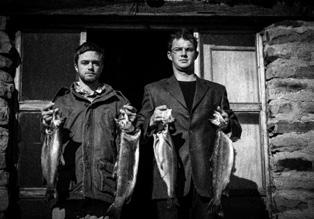

Here’s what I’m supposed to do. Settle down, work all day. Never s’posed to sport a frown. Looks like I’m living a lie – I feel ashamed. Light a cigarette. “Hey man! You got your insurance paid?”
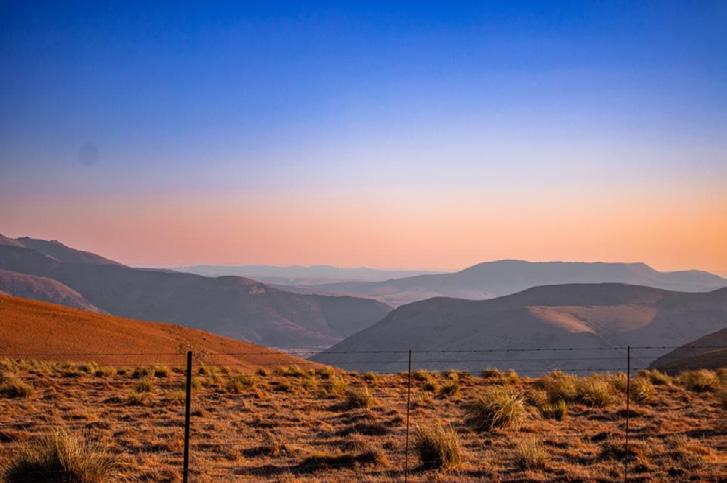
Patience in today’s world is a bit of an oxymoron. A faded rhetoric of a slow man in a fast world. Booze banned for a second time, no cigarettes for months, social media abuzz with new half-baked scientists and profound politicians, and my supermarket neighbour reminding me about load-shedding with their demonic industrial generators. I burn a candle. Patience is no longer a virtue but an obligation and the open documents on my laptop eye me curiously as though I’ve wandered into a labyrinth. I think I did. I like to think I’m the Minotaur and that I’ve been here all along waiting for the hero to slay and release me from this prison. Still, and in light of it all, it’s do or die. Aha! Maybe I’m not yet learning patience. So I reflect.
Growing up I had read a few bits and pieces about Thrift and was told stories of the cold stone cottages, strange trees and, in between the perennial windstorms, a few decent fish. It never really occurred to me that I would one day make it up to Thrift. Besides, I was convinced that fishing the small streams of Rhodes Village (ed: not to be confused with Rhodes University in Makhanda) in April was the only sensible way to get rid of what I then considered to be the ghastly non-native trout. I have since come a long way. Afterall, it was the lads of the RFFC who introduced me to life at Thrift.
The planning of a Thrift trip is a collegial merger of excitement and fear. The kind of feeling when it’s around one o’clock in the afternoon, you’re not ridiculously enthusiastic about the next lecture, and your friend gives you the, “What about a beer at The Rat” look (The Rat or Rat & Parrot, for the uninitiated, is Makhanda’s legendary student pub). In hindsight, you’re equally likely to have given him the same look. It’s the kind of confusion that contains equal parts guilt, intrigue, regret and a sparkle of “why not?” “We should go to Thrift.” I get the message while learning about protein trafficking in my biochemistry class. I ignore the message as I intend to focus on my studies. “Holy shit, yes!”, “Dude, I was thinking the same thing”, messages from others in the group chat. I can’t help but stare at my phone. No. Compose yourself. Now, an Introduction to Fisheries Management, as part of an Ichthyology module, is my next class and I can’t help but laugh. “I’m in”, I finally respond and remember little from that entire lecture.

I know I’m in trouble. Having not paid much attention in class means that I am subject to a few long nights and the associated fatigue. It’s terribly difficult to focus when you’re fixated on fun. Thankfully it’s not just me, as the haste to clear schedules seriously impedes my administrative progress. I scrounge for groceries and contraband. Bags finally packed and convinced that I’ve forgotten something, I meet up with the guys and draw a deep, breath to flood my head with oxygen. Tired eyes and spirits lightly lifted; we settle into the beautiful drive. The only thing on my mind now is the evening rise… oh, and those three beers, the lazy tippet and those bastard casting knots.

No morning is the same when you pay close attention. But pay even closer attention and you begin to unearth aspects of an unconsciously propagated routine. Little rituals I would catch myself performing without thinking. The first morning at The Loch is similar. My eyes open and the ceiling looks strange. Clearly I’m disoriented, so I look around the room and see one face, equally perplexed, looking back at me. We’re all mostly awake at the same time as it’s not easy to fight off the onset of a hangover alone, if you don’t have to. The cottage smells of stale smoke and soggy boots and I remember exactly where I am. Like déjà vu but I know for certain this has happened before and not only to me. It feels as though this has been lived by generations of Thrift-goers. It’s thrilling and terrifying. Thrilling because I know where I am and feel connected to this place. Terrifying because it makes me realise that I am not the centre of the universe, actually quite insignificant. As the days progress a few general trends emerge. The gentle breeze that makes removing weed from your double dropper a slight inconvenience, develops and makes the same procedure a little less tolerable. Jackets fill with countless wet flies which, in turn, means that sparsely packed boxes are running dry. I’m perpetually reminded of the yesterdays that resulted in no fish, but that’s okay because it doesn’t matter if I don’t catch anything. I’m here, that’s enough… Oh Satan, just one fish. And then,
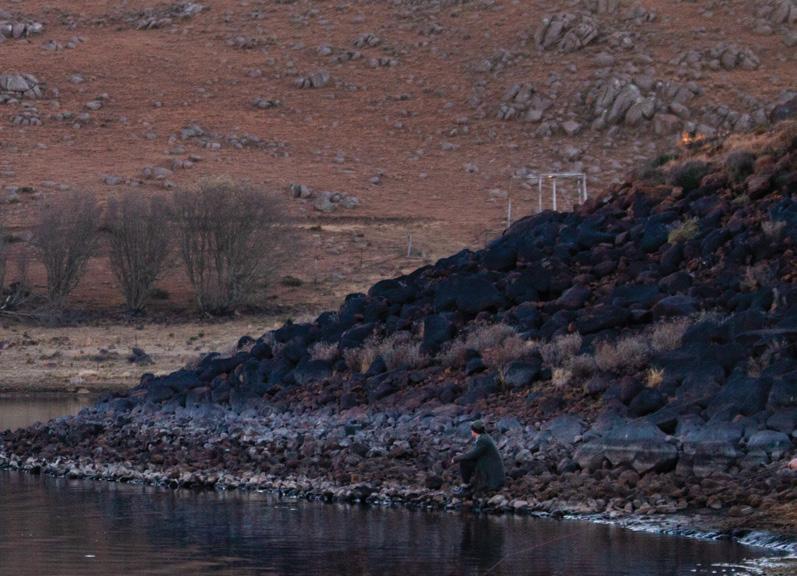
there’s this indiscernible buzzing that begins in the fingers and toes which then works its way into your body. It’s cold. I wonder if this isn’t my own doing. You see, I had suggested, the night before, that Jesus was a disinclined prophet. He was simply a far more spiritually advanced fellow who, in being himself, unwittingly attracted hordes of commoners begging for the gift of enlightenment. Perhaps, I took it too far upon commenting on how this may have led to Jesus suffering from depression, and in doing so compromised my chances of catching any fish. I certainly do feel responsible for the maddening wind. There’s nothing to do but sit in the cottage and stare at the remnants of the fire from last night. At least, there’s coffee. And with no sign of forgiveness from above, the wind justly persisted with its message of “Go home”. Not an angry wind, just disappointed. The harshness of this place is otherworldly. We decided to heed the wind’s call and wrap our muddy belongings in towels and clean what was deemed salvageable. I miss the coral trees that line the streets of Makhanda. I miss the Sloppy Joes cruising around, and the ones upstairs at The Rat. I miss walking through campus… in clean clothes. Heck, right now, I even miss the potholes. In the car I’m convinced I have forgotten something and a last-look is too frightening to consider. The blessed journey back to Lieutenant Colonel John Graham’s unfortunate pozzie. Until we meet again. One last thing… Thank you, Martin Davies (Ed: trout hatchery legend behind Thrift’s giant trout and a man who has done more for Eastern Cape fly fishing tourism than anyone else). This place is a second, distantly removed cousin of a home to us. We can’t get enough. Please consider the addition of a warm shower.
Sincerely,
The RUFFC.
Martin Davies netting trout at Thrift dam.

THRIFT INTERLUDE OF SUPERHEROES AND STRIPPERS
THINK OF STRIPPERS AND IT’S LIKELY THAT WHAT COMES TO MIND ARE POLES AND DANCING, GRINDING BOOTY, THONGS FLYING THROUGH THE AIR... YOU ARE UNLIKELY TO THINK OF MIDDLE-AGED/ ELDERLY MEN WITH NAMES LIKE MARTIN AND ALAN, STANDING KNEE-DEEP IN THE FRIGID WATERS OF THE EASTERN CAPE’S PREMIER STILLWATER, WORKING THEMSELVES STUKKEND AMID TROUT EGGS AND SPERM (OK, MILT). BUT, TO SOUTH AFRICAN FLY ANGLERS THE WORK THESE STRIPPERS DO WILL ARGUABLY RESULT IN HOURS MORE FUN AND VALUE IN THE LONG RUN. HERE, ED HERBST SHINES A LIGHT ON MARTIN DAVIES , THE MAD GENIUS BEHIND THE EASTERN CAPE’S TROPHY STILLWATER TROUT.
‘Thrift Dam is not for sissies’ is the headline on a YouTube clip but its unchallenged role as South Africa’s premier trophy trout dam is, in substantial measure, due to the singular role played in the region by Martin Davies, a nowretired ichthyologist from the Department of Ichthyology and Fisheries Science at Rhodes University in Makhanda - once known as Grahamstown - in the Eastern Cape. Martin, a graduate with a Master’s degree in Oceanography from the University of Southampton, arrived in South Africa in 1976 to study eels, a project financed by the Fisheries Development Corporation, a government department.
In due course he met Margaret Smith at Rhodes University, the wife of Professor J L B Smith best known for his discovery of the coelacanth and in 1984 and, at her invitation, he joined the university’s Department of Ichthyology and Fisheries Science At the time the province had a lot of high altitude and privately-owned trout dams which were dependent on annual stocking from the government trout hatchery at Pirie near King William’s Town in the Eastern Cape. The hatchery was fed by the Buffalo River and had a staff of 19. In the 1980s government policy changed. Whereas such hatcheries had previously supplied trout for stocking dams, it was decided to concentrate on indigenous fish. Despite antipathy within the university, Martin, with the help of private funding and using his own salary, set up a trout hatchery on university property using recycled municipal tap water. At the time, this was only the second such hatchery in existence, the other being in the USA. When Martin arrived in South Africa, the conventional stocking approach was to stock trout of around a kilogram
or more in dams in the belief that this would make them less likely to predation by bass, otters and cormorants. Martin advocated stocking fry because they would have less impact on the dam ecosystem and those that survived would be the equivalent of trout born in the wild. From 1984 until he reached obligatory retirement age in 2016, Martin voluntarily placed himself on 24-hour call, 365 days a year and also helped farmers to set up their own hatcheries.
In 1981 his first Master’s student graduated with a degree in aquaculture and there have been dozens since then, all equipped to earn a living in this form of farming. Along the way, Martin had a hand in establishing the Federation of Southern African Fly Fishers – FOSAF - a lobby group supporting the interests of fly anglers and that seeks to conserve the environments in which they fish. He also, with the help of Dave Walker of Rhodes, set up the Wild Trout Association, a conservancy in Barkly East, Rhodes and Maclear in 1991. It creates a mutually rewarding link between farmers and fly fishers and it now administers more than 350 kms of water. The Association, which is based in Rhodes, organises day ticket fishing for visitors, giving approximately 70% of the rod fee to the riparian owner and retaining the rest for admin fees. But it was Thrift Dam in the Winterberg Mountains near the village of Tarkastad that increasingly became central to Martin’s stocking programme. In the middle of winter, often with ice on the water, he and his helpers net trout, strip them and fertilise the eggs before growing them on in the hatchery which he has built at his home.
Through careful selection he has bred Kamloops-strain trout which are more warm water-tolerant and have reached double-figure weights. The biggest landed so far weighed 14 lbs., but double-figure trout are routinely caught there. And they are ferocious fighters. Alan Hobson, of ‘Wild Fly Fishing in the Karoo’ fame has, for many years, assisted Martin in stripping trout at Thrift and says his contribution to fly angling in the province is without parallel: ‘Adjectives cannot describe the heartfelt depth of Martin’s passion. A life’s journey creating the ‘ultimate stud’ of rainbow trout which is best adapted to the Eastern Cape’s diverse and adverse conditions - big tails, broad shoulders, vibrant colours and super-strong fighting fish surviving in extreme environments. For 40 years Martin has single-handedly ensured the longevity of rainbow trout in the Eastern Cape, in probably THE most difficult place
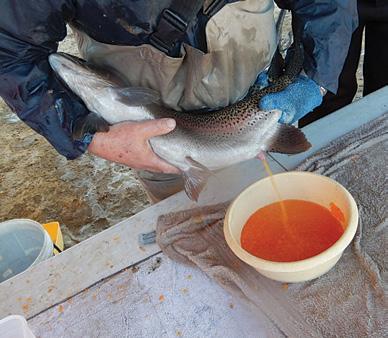
to breed trout. Grahamstown is renowned for irregular electricity supply, erratic weather and water laden with heavy metals, the most difficult circumstances in which to run a hatchery. His character, dogged determination, selfless dedication and sacrifice have provided the quality of fish we enjoy today. Martin is the “super hero” of trout fishing in the Eastern Cape - an absolute legend.’
The dams he has stocked in the Eastern Cape in the past three decades have contributed millions of Rands to the region through fly angling tourism - rod fees, accommodation and other trickledown benefits to local economies.
Alan Hobson has developed a fly for him which combines aspects of the New Zealand ‘Killer’ patterns and a zonker strip.
It resembles both crabs and the tadpole of the African Clawed Frog or Platanna - two staples in the diet of trout in the area - and it has a deservedly formidable reputation at Thrift Dam, South Africa’s premier destination for those who, thanks to Martin Davies, want a realistic chance of landing a double-figure trout. Alan says these trout simply straighten conventional medium-wire nymph and streamer hooks – a warning worth heeding.
THRIFT 2 WINTER MOUNTAIN TEMPEST
FOR LEROY BOTHA AND KYLE OVENS , IT WAS A LONG TREK TO THRIFT FROM THEIR HOMES ON THE GARDEN ROUTE, BUT IT WAS WORTH EVERY MINUTE.
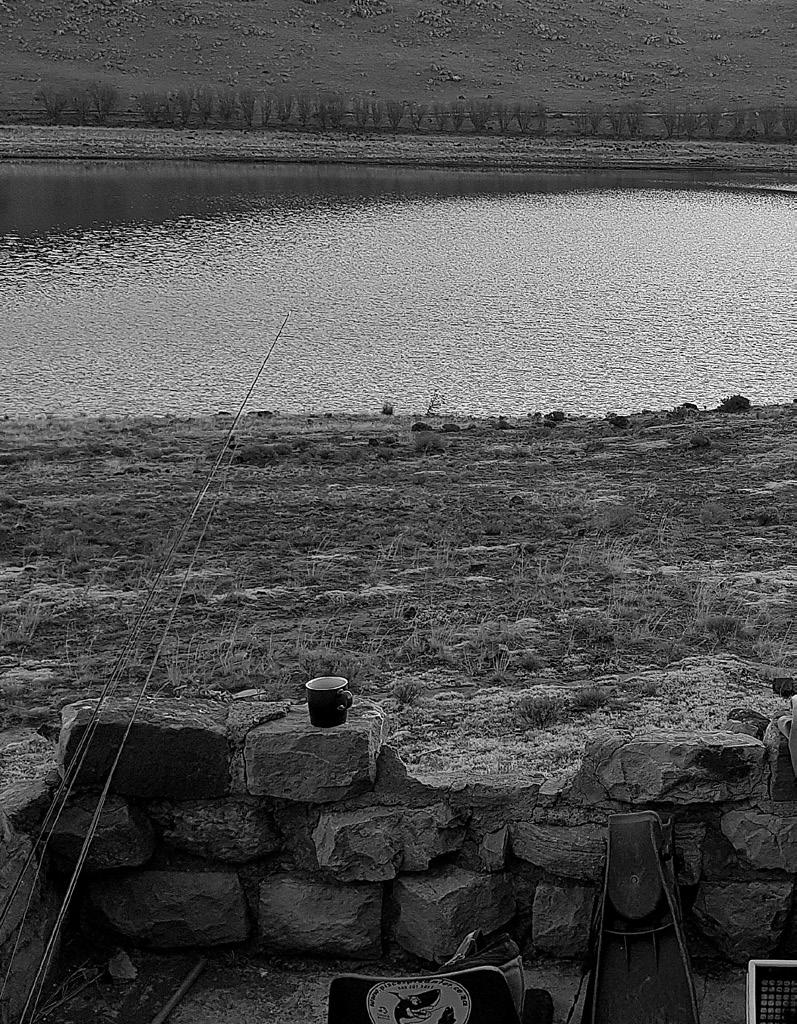
Words by LeRoy Botha Photos. LeRoy Botha and Kyle Ovens

Kyle Ovens in his kaleidoscopic Cossack outfit offering free hugs in the Thrift cottage.

This is Thrift. If you were planning to pay her a visit, I sincerely advise that you prepare for the worst. Because if you do, and if you’re willing to face it, she’ll give you her best. But be warned. She doesn’t suffer fools lightly.
“Four seasons in a day,” Kyle warns me about the mighty stillwater. I’d never been to Thrift Loch and, frankly, never thought I would. But I admit that, even as a river junkie, I have secretly dreamed of Thrift ever since catching a whiff of its reputation. I have little interest in Tupperware trout – those plastic, finless, brainless pellet-fed shadows of their ancestral selves that inhabit stew ponds all over the country. The kind of trout that beg for a coup de grâce, if only to free them from their inhospitable home and inevitable summer demise. I find them about as appealing as I did playing prop in my primary school rugby team. I know that some people find great joy in that sweaty shit and that is fine. But not me, man.
But Thrift is no stew pond and Kyle, I would say, was a little forgiving in his assessment of the weather. Home to overwintered, fit and healthy fish, you can barely hope for a wilder stillwater trout experience in South Africa. And you don’t get four seasons in a day as much as you get four manifestations of the Wrath of God.
In other words, it’s epic. Here’s what went down.
Road Trip: Amazing Grace
Kyle Ovens is a member of a band of brothers, the Trout Cowboys, who make an effort to visit Thrift on a yearly basis. This year none but Kyle could make the trip. But we recently met and found mutual ground in being equally flybesotted Garden Route residents, so he thought of inviting me along. Visiting Thrift on your own, he said, could do your head in. In retrospect, that’s not the only way Thrift will do your head in, but I gratefully accepted the invitation and plans commenced. Two weeks later we set off to the Winterberg – God’s Country – to find that holy water. The eight-hour road trip from the Garden Route is a breeze, the conversation easy in our shared love of music and fly fishing. The inland Eastern Cape towns we passed through, we agree, are godforsaken dumps in dire need of rescue. Cradock and Tarkastad are tragic blights the government would likely prefer us not to notice. Kyle assures me that these are not what we’re to encounter over the next few days. We’re primed for the embrace of Mother Nature. Despite being ready for gale-force winds, freezing temperatures, rain, hail and snow, and the opposite as well, I’d been warned that preparation may alone may not be enough. If it rains, you’ll get soaked. There is little the aged and bare stone cabins on the lake’s shore can do to prevent that. The thatch roofs just let it straight through. There is no electricity, and thus no hot water. In fact there is only running water if the rain tank’s pipes aren’t frozen
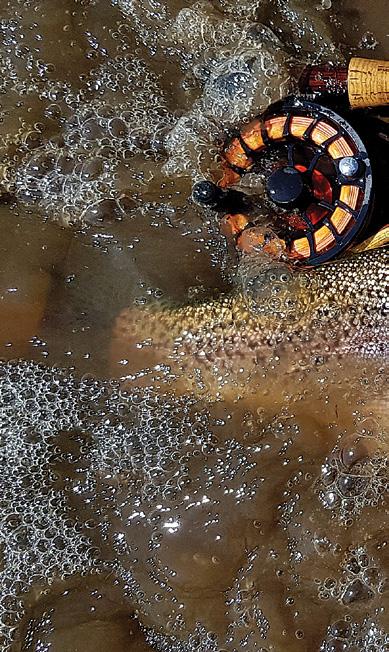
solid, so no showering for you, sir. You can fill the flush-loo with water from the lake, so at least a comfortable curl is possible, but don’t expect to call your mom or your missus while sitting there because there is no cell phone reception either. Yup. This place is raw. It ain’t the Ritz-Carlton. For those who prefer bubble baths and hot-rock massages, it’s hell. But happily, for reprobates like Kyle Ovens and myself, this is perfect: a place to escape, to get lost, to get found. Church.

That said, Clare, Kyle’s caring better-half, would be damned if we starved out here. Her pre-made meals coupled with Kyle’s considerable gas-fire catering skills ensured that, at the very least, we’d eat well. We arrive just before dark, and collect our keys from Elliot, the Lone Gatekeeper of Thrift. By the light of our headlamps we find our way and unpack, and before long sit down for a hot meal of lamb curry and rice. A beer or two later we’re ready for bed. Anxious to meet sunrise and the trout of Thrift, and enveloped by the Silence of the Middle of Nowhere, sleep does not come easy.
Day 1: Gales
Having downed a bowl of oatmeal and a cup of coffee, we don our waders and prepare our gear as I take my first gander over Thrift. The water is flanked by rusty hills peppered with gunmetal grey rocks and poplar trees, and trout are rising in the comparative calm of early morning. But we barely begin fishing before the first whispers of wind waft in, and before long the rise is blown out. The gales assault our casting efforts; feeding fish and a working pattern prove elusive. We work most of the near shore up and down in wind-blown conversation, until early afternoon

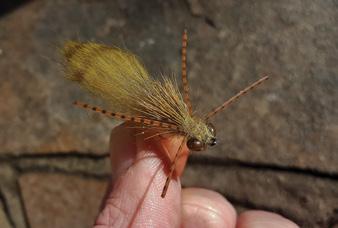
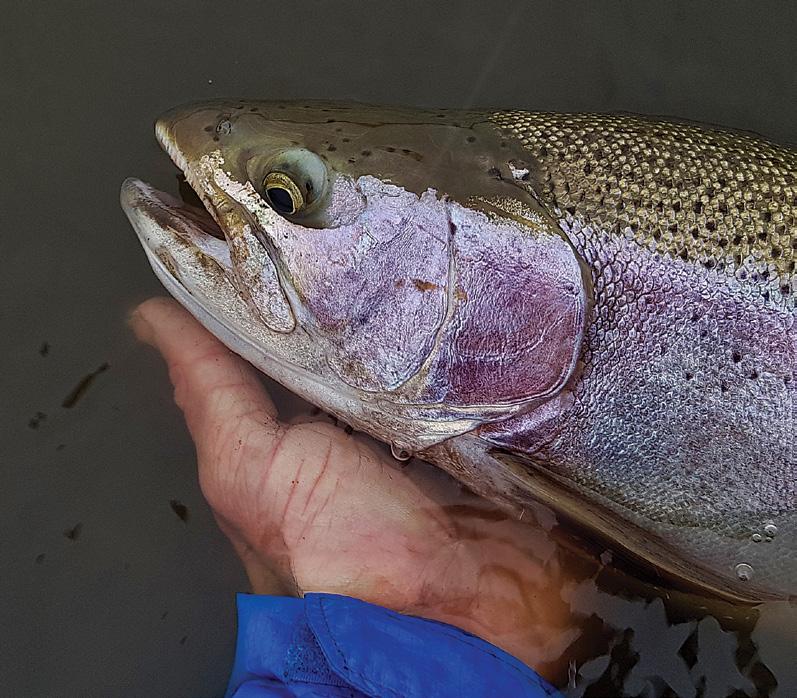
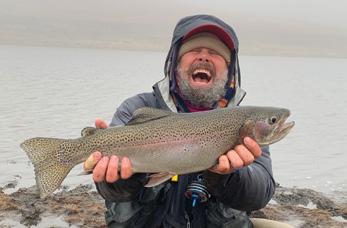

when I finally connect with the first fish of the trip, right back where we started. Being accustomed to small trout in tiny streams, I had professed that only one fish of 5lb or so would cement the fact that despite 2020’s utter butchery of normality, I’d had a good year of fishing. Hence, the 5,5lb fish that eventually eats my bottom-hopping leech makes my eyes water. So does the wind, but with the monkey off our backs we proceed with new determination, and scrape another fish each before calling it a day. At dinner we are joined by a pair of fat mice looking for floor scraps, and we debate whether or not to let them be. It wouldn’t be pretty if they got into our food stocks, Kyle says, to which I agree but add that I don’t mind them as long as they don’t bite my eyelids in my sleep. “Do they do that?!” “I don’t know, I just know that’s the place I’d least like to get chewed on.” Kyle is sitting on his bed as I scan for them with my headlamp when I perceive a shadow running across his lap. “It’s on you!” Kyle yelps like a kicked dog and damn near leaps through the roof before we realise it was a false alarm.
“I was joking about the eyelids...” We elect to evacuate the mice anyway, and a beer later we’re both snoring.
Day 2: Thunder and Lightning
For the first few hours of the second day, the weather ‘plays along’. Kyle prepares and launches his kick-boat, while I work the dam wall. We are joined by one bankbound day fisher who sets off to fish the near shore. A bit lost on my own in the land of stillwater trout, my mind veers left and right in a maze of the mundane and the task at hand. I manage a 3lb fish before four more day-visiting float tubers arrive. Among them only the lady fisher has any luck, catching four fish in quick succession. Eventually, a few hundred metres from me I hear the other bank fisherman cursing. I look up to see him stomp the ground and toss his rod into the grass. By now, Kyle had drifted far enough to be only barely visible, but I notice that he stays in one place for a while before heavy clouds build up and thunder starts roaring overhead.
The float tubers make for the shore. A large trout starts swimming around and about me, and I sort of enjoy watching him go about his business. He doesn’t care for any fly I throw at him, but some swirls over a nearby weed bed makes me wonder what an unweighted dragonfly nymph could achieve. Kyle is drifting closer. Petrichor fills the air as hard rain starts accompanying the thunder. We all leave the water and Kyle and I reconvene at the cabin.
“Did I give you that radio for decoration, man?” he jokingly scolds me, before telling me that he’d taken five fish on an unweighted dragonfly nymph fished over weed beds. I never noticed him catching his last one right in front of the hapless bank-bound fly fisher, but I argue that the karmic bitch-slap this could result in is probably cancelled out by the bank fisher’s earlier tantrum.
The float tubers leave as we sip on a cup of coffee, and the bank fisherman gives up when his entire family arrives to make lunch in the other cabin. The nasal braying of shelducks and bleating of lambs intensify with the weather. I can’t tell whether they love or hate it, but Kyle and I decide to brave it and walk the near shore in search of more dragonfly eaters. We’re a shivering, muddy, soaked mess by the time I accept that dragonflies are no longer doing the trick. I change to 4X tippet and tie on a size 14 buzzer, and within two casts hook into a 7lb fish. As it puts on a performance, I shout to Kyle.
“Buzzer, 4X, slow figure eight, bru!” “Hallelujah.” “Amen, brother.”
Kyle follows suit and shortly after I land my fish, he’s in with another 7 pounder. It’s a spectacularly pretty hen fish, and we celebrate her release with muddy high-fives and Viking laughter. On my next cast, I pin a 6lb cockfish – a fish I’ve dreamed of. As I unhook it, it bites down on my thumb, ripping bloody gashes with its needle-sharp teeth and, to add insult to injury, it jizzes all over my hand as I release it. “Don’t call them cocks for nothing,” I muse. Kyle promptly hooks another beautiful hen. By now, we look like shit. Stoked and wasted, we decide to go and get warm and dry and enjoy some food and drink. Kyle suggests that, weather permitting, I try his kick-boat in the morning. At nightfall, we are again joined by the mice, but this time we pay them no mind. With the white noise of rain pelting down on the thatch, we’re both goners within seconds of hitting the hay.
Day 3: Rain
The rain shows no sign of letting up, it is ice cold and windy, but I decide to take my maiden kick-boat voyage nonetheless. Much laughter ensues as I try to master turning left. Eventually I get it, Kyle wishes me luck, and I set off for his honey hole, once again with a dragon nymph at the ready. It’s a long, difficult kick away, but I reach it just in time to not die of a heart attack. Battling the wind for a good position from which to reach the weed beds, I eventually manage a cast and the fly immediately gets pasted by a 4lb fish. It wastes no time in getting its dolphin on, and by the time I net it, I’d drifted a hundred metres
LeRoy Botha (above) puts in the work and reaps the rewards (right). downwind. I press back and take the next available shot. A five pounder latches on, jumps a metre out of the water and torpedoes straight for me. I have little choice but to beach the boat and continue the fight from shore, but not before losing the flippers in the mud and dismantling the whole boat in an effort to escape it. I decide to deal with the mess only after taking a few more casts from shore. In quick succession, I get a four pound hen and a sixand-a-half pound one. Then a 5lb cockfish in a steelhead getup charges into my backing before showing me what a pissed-off rainbow trout can really do. It goes off like a cat about to be boiled alive, but I eventually manage to trick it into the net. Through all of this, Kyle justifiably elects to enjoy some warm R&R at the cabin, but we stay in contact via radio and share the laughs.

Now I could make a pig of myself and catch more, but I’m running out of ways to keep my phone and smokes dry, and my hands have transformed into swollen, white sponges. I reassemble the boat as best I can, dig out the
flippers and launch to let the wind carry me back to the cabin. I fool some more fish in the drift, one of which looks more cutthroat than rainbow, red chin lashes and all. This place is mind-blowing, I tell myself, grinning like a dork, drenched to the bone.
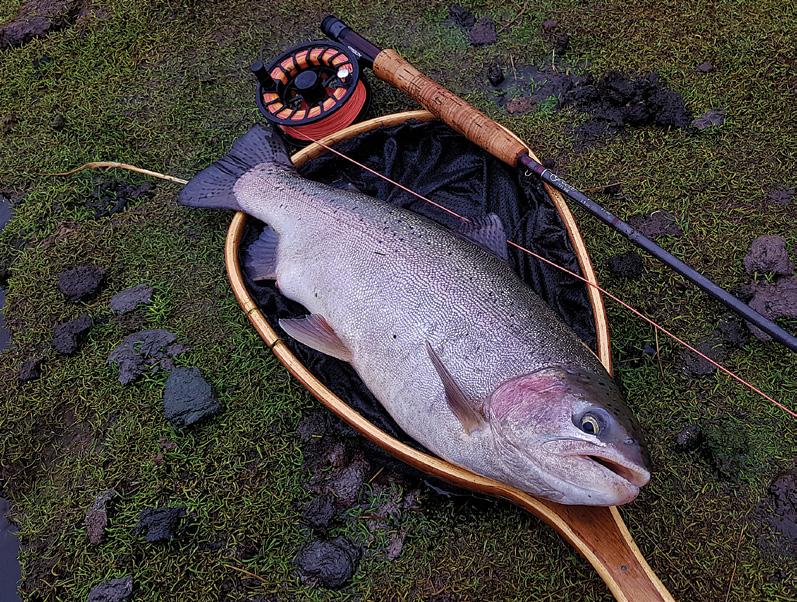
A short while later, we’re sipping celebratory beers and contemplating the last few hours we have for fishing. We’re in extra-time at Thrift, and not planning to waste it. I decide to stay in my wet ten-layer fishing disguise and we set off for a final walk along the near shore. It’s not long before we again switch to buzzers on light tippet. Despite clear signs of feeding fish, we battle for a bite. We add indicators to our rigs and attempt a static presentation, but the wind plays havoc with our setups and drifts. At this point, the lambs are sounding decidedly desperate, and I’m pretty sure I know how they feel about the weather. Kyle manages two good fish before I ask him for one of his giant floating buzzers to replace my cursed wool indicator, and I catch one last 5lb football on the tiny buzzer I hang from its bend. Now, we are done. Soaked, refrigerated, hands damn near dead, done. Lost and found at the Church of Thrift, we’re an unholy sight indeed.
The End: A wretch like me
On the long walk to the cabin the rain stops, and the wind dies down. A sliver of sunlight pokes through the clouds like a celestial middle finger. Thrift, for the first time on this trip, lies mirror calm and fish begin to rise all over it. Swallows join the trout in a feast of midges. We smile at the bittersweet irony, and let the fish enjoy the calm evening rise as much as we enjoy getting warm and dry. Kyle prepares some immaculate burgers before we clock out, and we sleep like stones as the mice enjoy our leftover patties. This is Thrift. She kicks your zip in, and leaves you begging for more. Bruised and battered but no longer mere acquaintances, we pack for the long road home, ready to do the time it will take to repent, recover and eventually, return.

SANTER WHEN THE RIVER RAN RED
REGARDLESS OF YOUR SKILL LEVEL, BEING AN ANGLER ALWAYS INVOLVES A MODICUM OF LUCK. IN GARETH TATE AND CRAIG PAPPIN’S CASE, THEY HIT THE MOTHERLODE IN A TSITSIKAMMA ESTUARY.
By Gareth Tate. Photos Gareth Tate and Craig Pappin
In my fly fishing life there are a few experiences and stories that stand out a little more than others. Having grown up in the bushveld in the Lowveld, many stories have involved me trying my utmost to not become part of the food chain while fishing wild waters. A fair few stories have involved navigating croc infested rivers and being chased by grumpy hippos, ellies and buffaloes. Bushveld bliss.
Many stories involve fishing adventures in gnarly, unpredictable weather. Like the time we were dodging lightning that was striking way too close for comfort on open water. The electricity and static in the atmosphere had the hair on our arms standing out on end. I don’t think I could have laid down any flatter on the deck of the boat than I did then, without causing organ damage. Or the time we had to seek shelter in a cave to escape golf ballsized hail stones. I still have scars on my head from those, yet we survived. Most memories imprinted on my mind, however, simply involve the extraordinary landscapes and wildlife that fly fishing takes me to and, of course, the mission and adventures we make to get there. This story stands out because it was so unexpected and, after chatting to some of the fishy experts to confirm it, downright rare and lucky. It began with a morning chorus of birds praising the start of a blissful, balmy summer day on the Tsitsikamma coast. The forest was alive with sounds and life. The first cicadas started to protest from the treetops indicating that it was time to move and hit the water. After a quick coffee, my lifelong pal and fishing co-adventurer, Craig Pappin and I hit the lagoon to fling some flies at the local leeries. After a productive morning on the seven weights and going weak at the knees several times watching submarine-sized grunters deny our turd flies, we headed back to the house for a breather.
The weatherman had predicted rain for that afternoon, so we knew we had to squeeze in some more fishing before the front pulled in. After an apple and a beer (don’t judge, I was on holiday) and, finally having convinced our significant others that where we wanted to go was a good idea and a lekker place to tan, we decided to head off to a fishy little spot that Craig had found down the coast. It was quite a hike to get there, especially because I chose to wear my favourire plakkies (flip-flops). The hike was worth it.

As the path snaked down the valley, the forest opened up to reveal a gorgeous little bay framed by jagged rocky shelves, waves lapping gently on its shores and a scene of true natural beauty. Clouds hung in the sky like large bunches of cotton wool. Ancient yellowwood trees towered over the forest canopy. A Fish eagle called from above. Knysna Turacos scurried among the treetops. The summer call of Sombre Greenbuls filled the air. Narina Trogons, one of our more beautiful and rare forest birds, called their mournful song as they welcomed us into the bay. It almost felt like we were the first people ever to set foot in this place. Paradise. To my right a tea-coloured river wound through the thickly-forested valley, eventually meeting the waves and spilling into the bay. As my dad would say, my litchis (eyeballs) were peeled wide open to take it all in.
We started off fishing the bay with no luck and, with the pushing tide, decided to head up the river. Apart from a few sizeable grunter tailing as we left the bay and meandered upstream, the river seemed quite devoid of any fish life. None of the shoals of baitfish, mullet and streepies that usually frequent these river systems. ‘Strange’, I thought to myself. After about a fifteen-minute barefoot walk inland (my plakkies were becoming cumbersome) along the riverbanks and a few river crossings, we found a deep little honey hole on the river bend that looked promising. In the hopes of enticing something up from the depths I cast a silicone mullet fly I’d tied the day before and that had proved deadly for the leeries that morning. A shad or a leerie would do. Nothing. A few more casts against a steep bank and a change of spot, however, brought something unfamiliar up from the bottom and into view. Out of nowhere, a mean looking fish with matched aggression, intercepted my fly on the surface. My heart nearly stopped. It was red in colour, with a blunt robust nose, and had that similar pissed-off temperament and look of a trevally. Although it was very interested in the fly, I couldn’t get it to commit on the surface. I quickly changed tactics and tied on a #4 olive over white flash clouser and lobbed it into the top end of the honey hole near a large, submerged tree. Immediately, four or five of these red submarines were now on their way towards my fly! A twitch-twitch-twitch and pause was all it took. Boom!! A fish hit the fly hard, hooked up and turned for the submerged tree. Naaier. My seven-weight protested as I applied full pressure and managed to turn the fish. The fight was over after a few solid runs and I brought the fish to the bank. My litchis were popping out of their sockets. It’s a Steenbras! It’s a red Stumpnose! No man, it’s a snapper! Wait, what the hell is it? Our shouts of both confusion and excitement reached the thick forest and flushed out o\ flocks of birds looking for a quieter neck of the woods. A beautiful red fish lay before us. It was perfect, had dark barring and its fins were edged with a brilliant electric blue. It had a serious set of gnashers that demolished my clouser quickly, and really strong jaws that clamped down on the fly when trying to unhook it. We had to keep fingers well clear. It was not a fish I’ve seen come out of a river or estuary in this area.
The fun continued for almost an hour after hooking that first fish, and I managed to catch a handful of these beautiful red river fish. At that stage I still had no clue what the species was. Some of them travelled in large shoals up to six or seven, while the larger specimens cruised alone. The bigger guys were aggressive and hit the fly hard, appearing from nowhere and broadsiding us like a GT when hooked. Some even took me into my backing providing a lot of excitement trying to avoid getting them caught up in the undergrowth and submerged trees. Craig had a larger clouser on and was struggling to get a clean hookup. He lost several fish that spat the fly and we were getting desperate to get him onto one of these mystery reds. We also knew that the women back in the bay were getting itchy feet and had hit their capacity tanning tolerance time and wanted to leave. So we quickly ran back and begged them for fifteen more minutes. It was granted: fifteen minutes and no more. Craig and I ran back to the honey hole. He put a good cast in. Twitch, twitch-twitch-twitch and pause. Boooom! First cast back there and he was on. The fish ran hard and took him into his backing. I remember shouting, “Shit Craig! This thing is kilometres away!!” He probably should’ve tightened his drag. After a good run, the fish was brought up to the shallows and landed. Once again, we marveled at this unknown red beauty, got some sick phots and a video and decided to pack it in.

Opposite page: Lowvelder Gareth Tate pulls off a rare estuarine-Santer hangbal.

Something about these fish, this experience, and this particular afternoon on the water seemed very special. Unique. Lucky. It felt like fishing in a place where the fish had never seen a fly before. They knew nothing about fly fishing and inhaled flies with enthusiasm. We are no fish experts, especially (as up country Vaalies) when it comes to the salt. So we started sending the photos and videos to our numerous groups of mates and fellow fly fisherman. That’s when the froth really began to grow. We soon identified these fish as Santer (Cheimerius nufar), a reefdwelling fish usually caught offshore. Now, santer aren’t a particularly rare fish and are regularly picked up using conventional tackle. They have also been caught on fly on the odd occasion. The more research we did, however, the more we realised how lucky we were to catch them on fly in this particular small Tistsikamma river system, especially the large adults. Our findings also confirmed that this was truly an at the right place at the right time kind of moment. After chatting to my good friend Steve Benjamin from Animal Ocean, who did most of the homework for me by chatting to all his marine fish specialists, the story of the santer caught up in this beautiful little river system, began to take shape. It is likely that extremely cold water from an upwelling event drove the santer up into the shallows of the bay and eventually pushed them to seek shelter in the warmer river water. Here they gathered in shoals where they likely grew hungry and aggressive. These fish had, indeed, probably never seen a fly before. Another theory of ours is that these aggressive reef fish also probably chased off all the other fishy inhabitants from this river. Which is why we didn’t see the usual shoals of baitfish typical to the area. What made this story even more exciting and extraordinary, was the following attempts to catch the santer on this river system over the subsequent days and weeks. Numerous friends and fisherman returned to the spot and flung flies of all sorts into the tea-coloured waters hoping to experience the red fish, with no luck whatsoever. The santer had simply disappeared, back to their deeper reefy homes. And so the remarkable adventures and flyfishing stories continue to grow for me. These unexpected and one-of-a-kind events are the experiences that keep us flyfishing and pursuing our quarry across beautiful places. I will never forget the day the river ran red.

